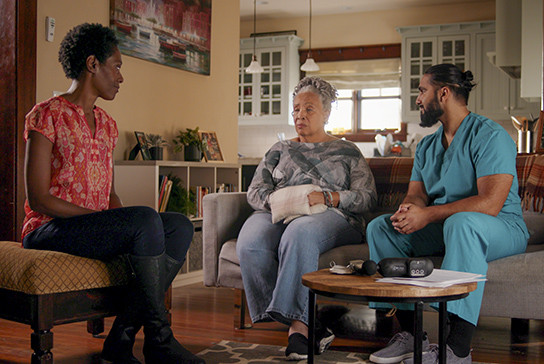AARP collaboration continues with new video series focused on caring for those living with pain
Home Alone Alliance provides resources for family caregivers as well as tools for nurses to support caregivers

Over the past six years, AARP’s Home Alone Alliance and the Family Caregiving Institute at the Betty Irene Moore School of Nursing produced more than 45 videos addressing issues that caregivers prioritized in national surveys. This year, the partnership expanded those offerings with a new series focused on helping family caregivers understand pain as well as familiarize them with ways to assess and treat it.
As with the seven how-to video series previously released, in addition to the videos produced for caregivers, the alliance also includes articles and resources for use by nurses and other health care professionals. Additionally, this latest series also explores the challenges faced by racially and ethnically diverse older adults and caregivers in managing pain.
“There is a substantial body of work that clearly show barriers and significant disparities in the management of pain for persons from underrepresented groups,” explained Heather M. Young, Family Caregiving Institute associate director for strategic partnerships. “In order to both educate nurses in how to support family caregivers as well as provide resources for caregivers, we have to grow understanding of experiences of caregivers caring for people with pain.”
Rita Choula, director of caregiving with the AARP Public Policy Institute and alliance leader, said it is important to acknowledge existing disparities in these resources.
“We thought it was important, although a difficult topic to hone in on. It would be blind of us to have a series focused on pain when people of all ethnicities are not believed when they talk about pain. We need to understand the hurt, the anxiety, which goes with that for the person in pain and the caregivers,” Choula said.
A dual approach

This is why, Choula said, the partnership with the Family Caregiving Institute is valued in reaching the goals of improving caregiver well-being, increasing awareness of family caregiving and recognizing caregivers as key partners with health care providers.
“We really saw an opportunity with the School of Nursing to embed preparing health care professionals to include caregivers and understand their challenges,” she said. “These are concrete solutions. These are serious issues that caregivers face and it takes a multipronged approach across sectors to make an impact.”
It’s for this reason, said Christine M. Spellman, executive director for the Mayday Fund, that the family foundation provided funding to publish a special section of the American Journal of Nursing with five new articles that include informational tear sheets to support nurses working with family caregivers.
“We are a small foundation and we believe no one should needlessly suffer from pain,” Spellman explained. “We were excited to have an opportunity to deliver information to communities across the spectrum of care. We were especially excited about working with nurses. Nurses are unique in their ability to listen and deliver care because they do so much care at the bedside.”
What next?
Home Alone Alliance partners plan to now focus efforts on further dissemination of the caregiving videos and resources.
“Over the course of the six years, we didn’t spend as much time disseminating the work as we did creating it,” Choula said. “Now we want to ensure these resources are getting out to family members, friends – making individuals aware that these resources are here.”
The partnership with the Family Caregiving Institute and other organizations was essential to reach this point.
“The success of this work built on the fact that so many were willing to come together to address this issue,” Choula said. “Together, we made a concerted effort to educate multiple audiences.”
For Young, this is confirmation the Family Caregiving Institute continues to meet its purpose.
“As part of the School of Nursing, we have the research and clinical expertise,” Young said. “AARP is a consumer organization with reach to the public. We can make the research come to life together – providing support for individual caregivers while also improving the systems of support for caregivers.”

